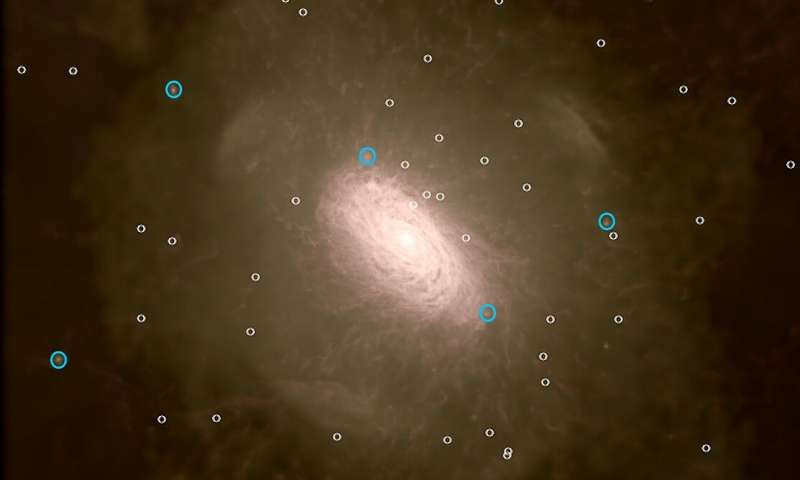Some of the oldest galaxies in the universe are right in front of our doorstep — cosmically speaking.

The blue circles surround brighter galactic satellites, the white circles ultrafaint satellites (so faint that they are not readily visible in the image). Ultrafaint satellites are amongst the most ancient galaxies in the Universe, beginning to form when the Universe was only about 100 million years old (compared to its current age of 13.8 billion years). The image has been generated from simulations from the Auriga project. Image credits: Institute for Computational Cosmology, Durham University, UK / Heidelberg Institute for Theoretical Studies, Germany / Max Planck Institute for Astrophysics, Germany.
The universe dark ages
Some 13.8 billion years ago (give or take), something pretty weird happened: the Universe started existing. According to the Big Bang theory, the universe formed out of a point of infinite density and temperature. In the immediate second after the Big Bang, a whole bunch of weird processes started taking place. The four fundamental forces started taking hold but the temperature of the universe was still too high to allow the formation of particles.
Then, after around 377,000 years, the universe had cooled to a point where free electrons could combine with the hydrogen and helium nuclei to form neutral atoms. This is where it gets tricky: although the universe had cooled down and was essentially transparent, nothing that could produce light had yet formed. There were no stars, no galaxies, maybe some primordial black holes and other structures — but no light. The universe was dark and essentially unobservable.
This is the so-called Dark Age of the universe.
[panel style=”panel-info” title=”Looking back in time” footer=””] Observing a faraway cosmic object is like looking back in time. For instance, when something is 1 million light years away, we’re perceiving it as it was 1 million years ago — because that’s how long it took light from it to get to us.
But because in its opaque form there were no light-producing structures, we can’t look back to that period of time. It simply remains hidden to us — at least as far as visible light is concerned. [/panel]
Eventually, stars and galaxies started forming — and some of these early galaxies were recently discovered by British astronomers.
Our old neighbors

Image of a galaxy generated from simulations from the Auriga project. Credit: Institute for Computational Cosmology, Durham University, UK / Heidelberg Institute for Theoretical Studies, Germany / Max Planck Institute for Astrophysics, Germany.
The research team has found evidence that the faintest satellite galaxies orbiting our own Milky Way galaxy are amongst the very first galaxies to form in our Universe. The galaxies they identified were likely formed more than 13 billion years ago — right after the Dark Ages settled in.
Prof Carlos Frenk, from Durham University, UK, and one of the study authors said:
“Finding some of the very first galaxies that formed in our Universe orbiting in the Milky Way’s own backyard is the astronomical equivalent of finding the remains of the first humans that inhabited the Earth. It is hugely exciting.”
If their findings are confirmed, that would mean that the galaxies emerged just 380,000 years after the Big Bang, which means they formed by some of the first atoms in the universe.
Remarkably, the data fitted perfectly with a model of galaxy formation that the team had previously developed — the model essentially allowed them to infer the formation times of the satellite galaxies, and now, observation has confirmed the model.
“Our finding supports the current model for the evolution of our Universe, the ‘Lambda-cold-dark-matter model’ in which the elementary particles that make up the dark matter drive cosmic evolution,” Frenk adds.
It’s always exciting when theoretical and real data blend in so well together and, as Dr. Sownak Bose points out, we simply wouldn’t have had the technological capacity to carry out this study a decade or two ago. Bose, who was a Ph.D. student at the ICC when this work began and is now a research fellow at the Harvard-Smithsonian Center for Astrophysics, concluded:
“A decade ago, the faintest galaxies in the vicinity of the Milky Way would have gone under the radar. With the increasing sensitivity of present and future galaxy censuses, a whole new trove of the tiniest galaxies has come into the light, allowing us to test theoretical models in new regimes.”
The work was carried out as part of the Auriga project — a large suite of high-resolution simulations of Milky Way-sized galaxies, simulated in a fully cosmological environment by means of the ‘zoom-in’ technique. Read more about Auriga here.
Journal Reference: Sownak Bose, Alis J. Deason, and Carlos S. Frenk. “The Imprint of Cosmic Reionization on the Luminosity Function of Galaxies,” The Astronomical Journal.









